Related Research Articles
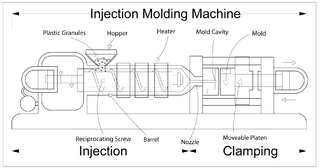
Injection moulding is a manufacturing process for producing parts by injecting molten material into a mould, or mold. Injection moulding can be performed with a host of materials mainly including metals, glasses, elastomers, confections, and most commonly thermoplastic and thermosetting polymers. Material for the part is fed into a heated barrel, mixed, and injected into a mould cavity, where it cools and hardens to the configuration of the cavity. After a product is designed, usually by an industrial designer or an engineer, moulds are made by a mould-maker from metal, usually either steel or aluminium, and precision-machined to form the features of the desired part. Injection moulding is widely used for manufacturing a variety of parts, from the smallest components to entire body panels of cars. Advances in 3D printing technology, using photopolymers that do not melt during the injection moulding of some lower-temperature thermoplastics, can be used for some simple injection moulds.

Ultrasonic welding is an industrial process whereby high-frequency ultrasonic acoustic vibrations are locally applied to workpieces being held together under pressure to create a solid-state weld. It is commonly used for plastics and metals, and especially for joining dissimilar materials. In ultrasonic welding, there are no connective bolts, nails, soldering materials, or adhesives necessary to bind the materials together. When applied to metals, a notable characteristic of this method is that the temperature stays well below the melting point of the involved materials thus preventing any unwanted properties which may arise from high temperature exposure of the materials.
Thermoforming is a manufacturing process where a plastic sheet is heated to a pliable forming temperature, formed to a specific shape in a mold, and trimmed to create a usable product. The sheet, or "film" when referring to thinner gauges and certain material types, is heated in an oven to a high-enough temperature that permits it to be stretched into or onto a mold and cooled to a finished shape. Its simplified version is vacuum forming.

Vacuum forming is a simplified version of thermoforming, where a sheet of plastic is heated to a forming temperature, stretched onto a single-surface mold, and forced against the mold by a vacuum. This process can be used to form plastic into permanent objects such as turnpike signs and protective covers. Normally draft angles are present in the design of the mold to ease removal of the formed plastic part from the mold.

Blow molding is a manufacturing process for forming and joining together hollow plastic parts. It is also used for forming glass bottles or other hollow shapes.

Microcellular plastics, otherwise known as microcellular foam, is a form of manufactured plastic fabricated to contain billions of tiny bubbles less than 50 microns wide. It is formed by dissolving gas under high pressure into various polymers, relying on the phenomenon of thermodynamic instability to cause the uniform arrangement of the gas bubbles, otherwise known as nucleation. Its main purpose was to reduce material usage while maintaining valuable mechanical properties. the density of the finished product is determined by the gas used. Depending on the gas, the foam's density can be between 5% and 99% of the pre-processed plastic. Design parameters, focused on the foam's final form and the molding process afterward, include the type of die or mold to be used, as well as the dimensions of the bubbles, or cells, that classify the material as a foam. Since the cells' size is close to the wavelength of light, to the casual observer the foam retains the appearance of a solid, light-colored plastic.

Rotational molding involves a heated hollow mold which is filled with a charge or shot weight of material. It is then slowly rotated, causing the softened material to disperse and stick to the walls of the mold. In order to maintain even thickness throughout the part, the mold continues to rotate at all times during the heating phase and to avoid sagging or deformation also during the cooling phase. The process was applied to plastics in the 1950s but in the early years was little used because it was a slow process restricted to a small number of plastics. Over time, improvements in process control and developments with plastic powders have resulted in increased use.
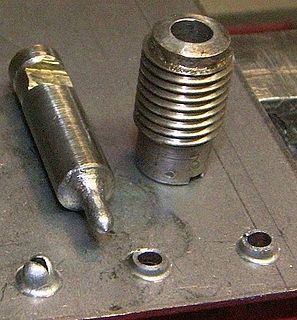
Punching is a forming process that uses a punch press to force a tool, called a punch, through the workpiece to create a hole via shearing. Punching is applicable to a wide variety of materials that come in sheet form, including sheet metal, paper, vulcanized fibre and some forms of plastic sheet. The punch often passes through the work into a die. A scrap slug from the hole is deposited into the die in the process. Depending on the material being punched this slug may be recycled and reused or discarded.
Spin casting, also known as centrifugal rubber mold casting (CRMC), is a method of utilizing inertia to produce castings from a rubber mold. Typically, a disc-shaped mold is spun along its central axis at a set speed. The casting material, usually molten metal or liquid thermoset plastic, is then poured in through an opening at the top-center of the mold. The filled mold then continues to spin as the metal solidifies.
Rotary wheel blow molding systems are used for the high-output production of a wide variety of plastic extrusion blow molded articles. Containers may be produced from small, single serve bottles to large containers up to 20-30 liters in volume - but wheel machines are often sized for the volume and dimensional demands of a specific container, and are typically dedicated to a narrow range of bottle sizes once built. Multiple parison machines, with high numbers of molds are capable of producing over one million bottles per day in some configurations.
In-mould labelling is the use of paper or plastic labels during the manufacturing of containers by blow molding, injection molding, or thermoforming processes. The label serves as the integral part of the final product, which is then delivered as pre-decorated item. Combining the decoration process with the moulding process cuts the total cost, but can increase the manufacturing time. The technology was first developed by Owens-Illinois in cooperation with Procter & Gamble to supply pre-labelled bottles that could be filled on the product filling line. This was first applied to Head & Shoulders shampoo bottles.

Flash, also known as flashing, is excess material attached to a molded, forged, or cast product, which must usually be removed. This is typically caused by leakage of the material between the two surfaces of a mold or between the base material and the mold in the case of overmolding.
Fusible core injection molding, also known as lost core injection molding, is a specialized plastic injection molding process used to mold internal cavities or undercuts that are not possible to mold with demoldable cores. Strictly speaking the term "fusible core injection molding" refers to the use of a fusible alloy as the core material; when the core material is made from a soluble plastic the process is known as soluble core injection molding. This process is often used for automotive parts, such as intake manifolds and brake housings, however it is also used for aerospace parts, plumbing parts, bicycle wheels, and footwear.
Injection molding of liquid silicone rubber (LSR) is a process to produce pliable, durable parts in high volume.

An injection molding machine, also known as an injection press, is a machine for manufacturing plastic products by the injection molding process. It consists of two main parts, an injection unit and a clamping unit.

The Bemis Manufacturing Company is an American manufacturing company based in Sheboygan Falls, Wisconsin, and is best known for its toilet seat products. Bemis also manufactures plastic lawn, commercial, and indoor furniture, suction canisters, sharps containers, fluid management systems, gas caps, gauges and various contracted extrusion and injection molded plastic parts for companies such as John Deere and Whirlpool Corporation. The company is a pioneer of co-injection molding, a process in which virgin resin is injected with scrap plastic.
Hobby injection molding machines, also known as benchtop injectors, hold molds on a smaller scale. Benchtop injectors have become more common as inexpensive CNC milling machines have reduced the cost of producing molds in a home workshop.
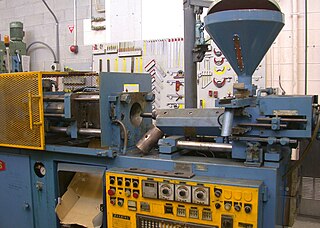
Injection molding has been one of the most popular ways for fabricating plastic parts for a very long time. They are used in automotive interior parts, electronic housings, housewares, medical equipment, compact discs, and even doghouses. Below are certain rule based standard guidelines which can be referred to while designing parts for injection molding considering manufacturability in mind.
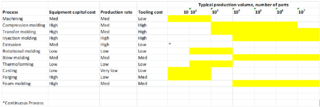
The economics of plastics processing is determined by the type of process. Plastics can be processed with the following methods: machining, compression molding, transfer molding, injection molding, extrusion, rotational molding, blow molding, thermoforming, casting, forging, and foam molding. Processing methods are selected based on equipment cost, production rate, tooling cost, and build volume. High equipment and tooling cost methods are typically used for large production volumes whereas low - medium equipment cost and tooling cost methods are used for low production volumes. Compression molding, transfer molding, injection molding, forging, and foam molding have high equipment and tooling cost. Lower cost processes are machining, extruding, rotational molding, blow molding, thermoforming, and casting. A summary of each process and its cost is displayed in figure 1.
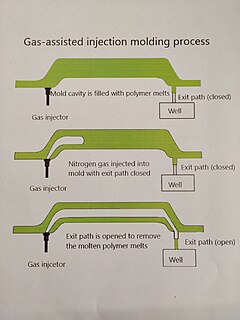
Gas-assisted injection molding is a molding process where an inert gas is introduced at pressure, pushing the plastic melts into the mold extremities at the end of the polymer injection phase.
References
- 1 2 [Evalene PHJ4501: Superior Material For Thin-Wall Injection Molding by Jums Belezza, JG Summit Petrochemical Corporation, 2006]
- 1 2 [Consumer Products: Customer Demands for Thinner Walls and Lightweight Designs Pose Challenges for Moldmakers, Mold Making Technology Magazine, 6/20/2011]
- 1 2 [Thin wall packaging users are seeking more from less by Chris Smith, Injection World Magazine, April 2012]
- 1 2 [Lightening Up The Auto Industry by Chris Smith, Injection World Magazine, June 2012]
- 1 2 3 [Using thin wall to create medical devices, by Clare Frissora and Greg Tremblay, Medical Device and Diagnostic Magazine, July 1, 2008]
- ↑ [SABIC’S XENOY IQ* RESIN HELPS CANON ELECTRONICS MEET GLOBAL CUSTOMER DEMAND FOR ECO-RESPONSIBLE PRODUCTS WITH NEW SCANNER HOUSING, PITTSFIELD, Ma./ USA -- April 2, 2012
- ↑ [Stretching the limits in rigid packaging by Chris Smith, Injection world Magazine, March 2012]
- 1 2 [Bayer Materials Science, "Thin-wall technology in the mobile phone industry" ATI 978 d,e]01/03/1997
- ↑ [Injection Moulding Pocketbook, Mannesmann Demag, Kunststofftecknik, p131]
- ↑ [The maintenance route to cost reduction by Jerry Claunch, Injection World Magazine, April 2011]